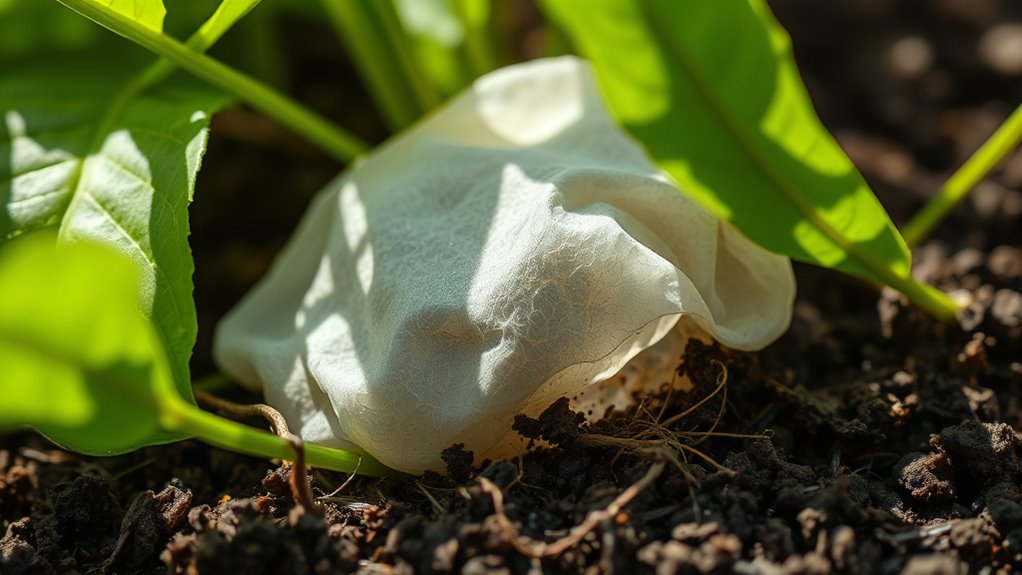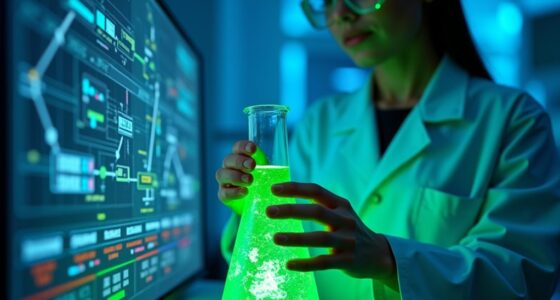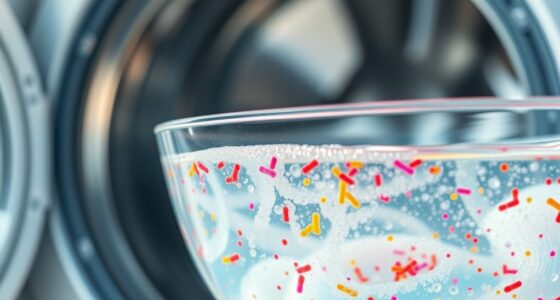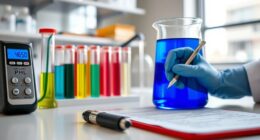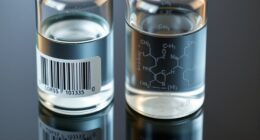To be truly compostable, a plastic must break down quickly and completely in industrial or home composting conditions through microbial action that transforms it into nutrient-rich soil without producing toxic residues. This requires specific chemical structures, like hydrolyzable bonds, and properties such as controlled crystallinity and surface design that encourage microbial growth. Certified standards ensure these plastics meet environmental goals. Keep exploring to understand how materials and microbes work together for eco-friendly disposal.
Key Takeaways
- Truly compostable plastics possess chemical bonds like esters or amides that can be hydrolyzed by microbes.
- They have a suitable chemical structure, low crystallinity, and appropriate morphology to facilitate microbial enzyme access.
- Certified compostable plastics meet standards (e.g., ASTM D6400, EN 13432) through independent testing of biodegradation and disintegration.
- Environmental conditions such as optimal temperature (30–40°C), moisture, oxygen, and neutral pH are essential for active microbial breakdown.
- Incorporating biodegradable polymers from renewable resources and designing for complete mineralization ensures eco-friendly decomposition.
Understanding Microbial Plastic Breakdown
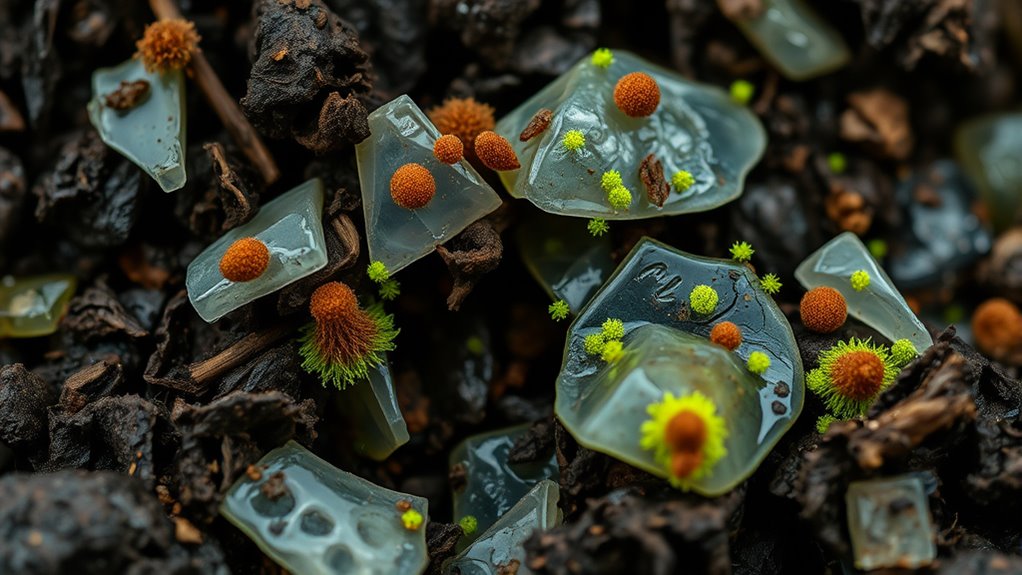
Understanding microbial plastic breakdown involves examining how microbes secrete enzymes that attach to plastic surfaces and hydrolyze the polymers into smaller, more manageable molecules. These extracellular enzymes, called depolymerases, cleave long polymer chains into low molecular weight oligomers or monomers.
Microbes secrete depolymerases that hydrolyze plastics into smaller, usable molecules.
Once broken down, these small molecules can cross microbial cell membranes for uptake and metabolism. Enzymatic hydrolysis leads to biofragmentation, producing fragments that microbes can utilize as energy sources.
Complete degradation, or mineralization, then converts these products into carbon dioxide, water, and microbial biomass. Microbes actively participate in this process, producing enzymes and reactive compounds that initiate and sustain plastic breakdown.
This complex interplay of enzymatic activity and microbial metabolism underpins the natural recycling of plastics in the environment.
Key Environmental Factors Influencing Degradation
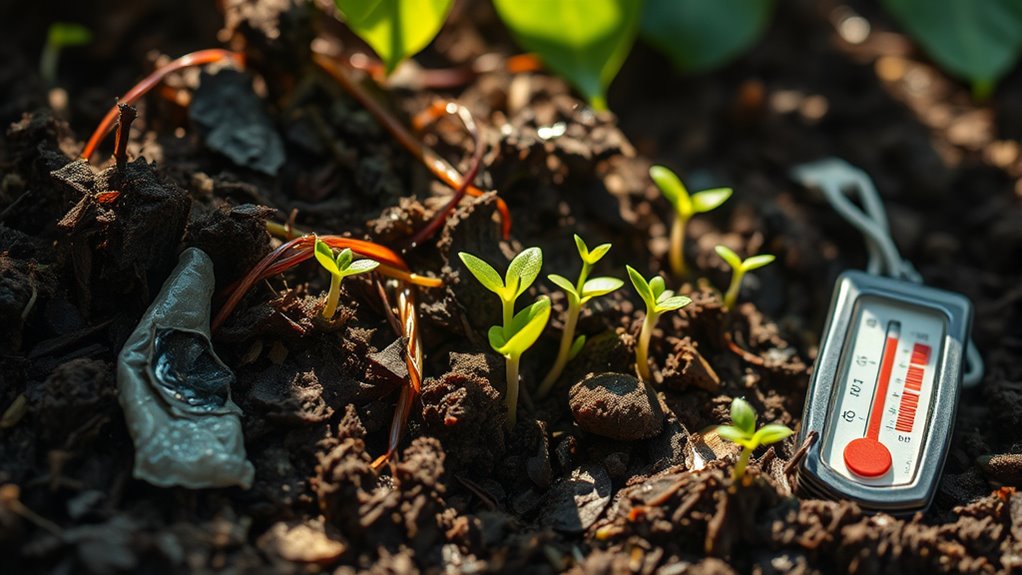
Environmental conditions play a pivotal role in determining the rate and extent of plastic biodegradation. Temperature affects microbial activity, with 30°C–40°C being paramount; colder environments slow down the process, and high temperatures can cause abiotic breakdown without full mineralization. Additionally, the presence of Home Theatre Projector Technology influences how effectively microbes can break down plastics in different settings. Oxygen availability is vital; aerobic microbes need oxygen to degrade plastics efficiently, while anaerobic conditions, like those in landfills, hinder degradation. Nutrients such as nitrogen and phosphorus support microbial growth; their scarcity, especially in marine or low-nutrient environments, slows breakdown. Moisture facilitates hydrolytic processes but excessive dryness or oxygen limitation hampers microbial activity. Additionally, pH levels influence microbial communities; neutral pH favors degradation, while acidic or toxic conditions inhibit microbes and slow the process. The availability of suitable microbial populations also plays a critical role in the biodegradation rate of plastics. Moreover, understanding the cost-effectiveness of biodegradable plastics can influence their adoption and environmental impact. These factors collectively determine how quickly and thoroughly plastics biodegrade.
Physical and Chemical Properties That Affect Biodegradability

The physical and chemical properties of plastics directly influence how easily they biodegrade. Surface area plays a key role; larger areas allow more microbial attachment and faster enzymatic breakdown. Hydrophilic surfaces absorb water and promote microbial colonization, speeding up degradation, while hydrophobic surfaces resist these processes. Additionally, surface roughness creates niches for microbes, enhancing adhesion, and biofilms on surfaces protect microbes, further aiding breakdown. Chemically, polymers with hydrolyzable bonds like esters in polyesters are more biodegradable because enzymes can cleave them easily. Higher molecular weights slow degradation due to longer chains, and the presence of side chains can hinder enzyme access. Crystallinity, Tg, and morphology also matter—they influence chain mobility and accessibility, affecting how quickly microbes can break down the material. Other factors such as the composition of additives in plastics can also significantly impact biodegradability by either promoting or hindering microbial activity. Moreover, the physical structure of the polymer can influence how microbes interact with it, with more amorphous regions generally being more accessible for microbial attack.
Designing Plastics for Complete Composting
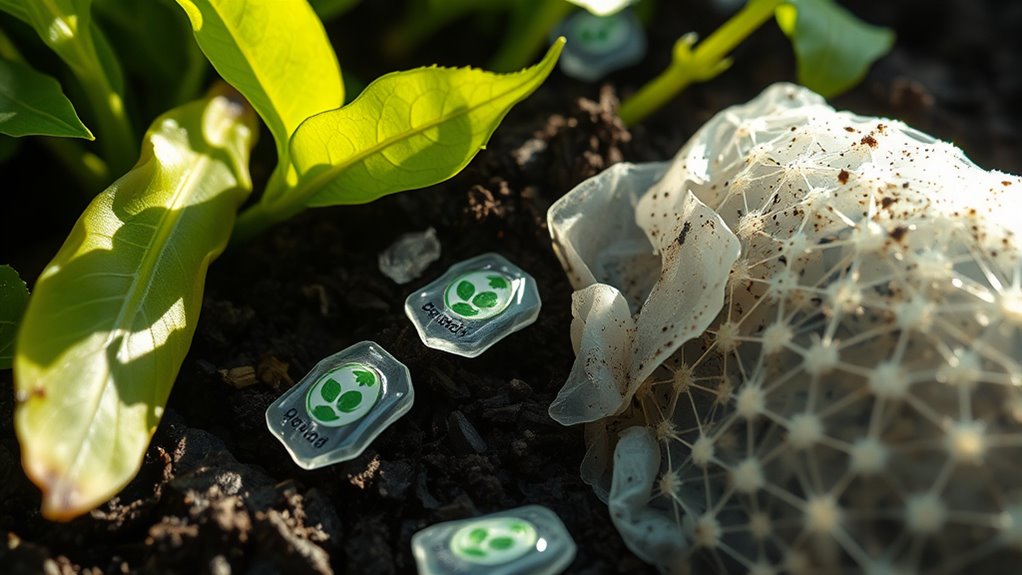
Designing plastics that can fully break down in composting environments involves selecting appropriate materials and incorporating specific features to enhance biodegradability. You should focus on bio-based polymers like starch, PLA, and PBS, which naturally decompose under composting conditions. Incorporating imagination in design approaches can lead to innovative solutions that improve environmental impact. Embedding enzymes that target polyester bonds can speed up degradation, especially when combined with materials that respond well to heat and moisture. Using polymer blends can improve compostability across various settings, from home to industrial composters. Additionally, optimizing the degradation process by controlling environmental factors such as aeration, temperature, and moisture levels ensures more efficient breakdown. Ensuring proper aeration and maintaining ideal temperature and moisture levels are essential for facilitating microbial activity and rapid breakdown. By carefully choosing materials and designing for environmental conditions, you create plastics that not only break down efficiently but also contribute nutrients back to the soil, reducing waste and environmental impact.
Standards and Certification for Compostable Plastics

Understanding the standards and certifications for compostable plastics is essential to guarantee products meet safety and environmental performance criteria. Certification bodies like the Biodegradable Products Institute (BPI) in North America and DIN Certco in Europe set rigorous standards such as ASTM D6400, D6868, and EN 13432. These standards specify biodegradability, disintegration, and ecotoxicity requirements, ensuring plastics break down safely in industrial composting facilities. Certification involves extensive testing—biodegradability, disintegration, and chemical safety—conducted by independent labs. Vetted certification processes ensure that only compliant products receive official recognition. Certified products display labels like the BPI or Seedling logo, which help consumers and composters identify verified compostable items. These labels promote transparency, reduce greenwashing, and guarantee products are compatible with commercial composting systems, supporting effective waste management and environmental sustainability.
Overcoming Challenges in Plastic Biodegradation

Environmental factors like temperature, humidity, and microbial presence play a critical role in the biodegradation process, often determining how quickly plastics break down. Warmer temperatures and ideal humidity boost microbial activity, speeding up decomposition.
Environmental conditions like temperature and humidity significantly influence how quickly plastics biodegrade.
However, the hydrophobic nature of some plastics limits microbial colonization, slowing the process. Mechanical stress can fragment plastics but rarely results in complete breakdown.
UV radiation breaks plastics into microplastics but doesn’t promote full biodegradation. Additionally, natural environments often lack the specific conditions found in composting facilities, making degradation slower or incomplete.
Overcoming these challenges requires controlling environmental factors and developing materials suited for diverse conditions. Improving waste collection systems and establishing clear separation practices are essential steps to ensure biodegradable plastics are properly processed, ultimately enhancing their environmental benefits.
The Role of Microbial Enzymes and Biotechnology

Microbial enzymes such as hydrolases, lipases, and cutinases are essential players in plastic biodegradation because they directly break down polymer chains into smaller, more manageable molecules. They do this by attaching to the plastic surface and hydrolyzing or oxidizing bonds within the polymer.
Microorganisms from soil, marine, and other environments produce these enzymes, with some being more effective on high-molecular-weight plastics.
Advances in biotechnology aim to enhance enzyme stability and activity, making degradation faster and more efficient. Gene engineering helps improve enzyme performance, while selecting specific microbial strains optimizes degradation for different plastics.
These innovations support sustainable solutions, enabling microbes to metabolize plastic fragments into harmless byproducts like carbon dioxide and water, advancing eco-friendly waste management.
Material Composition and Its Impact on Decomposition

The chemical structure of plastics plays a crucial role in determining how easily they decompose, especially in composting conditions. Plastics with hydrolysable bonds like ester, amide, or ether groups are more susceptible to microbial attack, allowing them to be broken down into monomers that microbes can metabolize.
Hydrophobic polymers, such as polyethylene, hinder microbial adhesion and slow biofilm formation, reducing biodegradation efficiency. Your material’s chemical composition influences microbial access and degradation pathways more than whether it’s bio-based or petroleum-based.
Blending biodegradable polymers can adjust degradation rates by modifying chemical makeup. Additionally, factors like crystallinity, molecular weight, and additives affect how quickly and effectively a plastic decomposes.
Proper formulation ensures the material’s compostability aligns with environmental conditions, optimizing breakdown in composting environments.
Assessing the Environmental Benefits of Truly Compostable Plastics

Truly compostable plastics offer a practical solution to reduce landfill waste and support sustainable waste management. By decomposing naturally in composting systems, they divert organic waste from landfills, decreasing overall waste volume.
Unlike traditional plastics, compostable options break down into nutrient-rich soil, which enhances soil health and reduces reliance on chemical fertilizers. This process aligns with increasing landfill regulations aimed at sustainable waste practices.
Additionally, composting reduces greenhouse gases like methane, which are emitted when organic waste decomposes anaerobically in landfills. Using renewable resources for producing compostable plastics lowers fossil fuel dependence and energy consumption.
These materials also protect wildlife and ecosystems by minimizing long-term environmental hazards, supporting the broader goals of a circular economy and fostering community awareness of eco-friendly waste management solutions.
Frequently Asked Questions
How Do Additives Influence a Plastic’s Compostability?
Additives impact your plastic’s compostability by accelerating its biodegradation process, attracting microorganisms to break down the material faster. However, they don’t guarantee complete, safe breakdown into organic matter within a specific timeframe.
In fact, these additives often require industrial composting conditions, and they can hinder recycling efforts. So, while they may help plastics degrade quicker, they don’t necessarily make your plastic truly compostable or environmentally harmless.
What Are Common Testing Methods for Verifying Compostability?
Testing tools tell the tale of a plastic’s compostability. You’ll likely rely on ASTM D6400, which checks biodegradation, disintegration, and ecotoxicity, or ISO 14855-2, measuring CO2 release during controlled composting.
The ASTM D5338 test quantifies biodegradation via CO2 production in simulated environments. These methods guarantee your materials meet strict standards, confirming their safe, sustainable breakdown in composting facilities, and verifying their environmental friendliness effectively.
Can Biodegradable Plastics Harm Soil or Marine Ecosystems?
You might wonder if biodegradable plastics pose risks to soil or marine ecosystems. They can harm soil by altering microbial diversity or affecting nutrient balance if not properly managed.
In marine environments, they can break down into microplastics, which threaten marine life and human health. Proper disposal and controlled composting are essential to minimize these risks, ensuring biodegradable plastics don’t become environmental hazards.
How Long Does It Typically Take for Plastics to Fully Compost?
You wonder how long plastics take to fully compost, right? Imagine tossing a plastic bag or bottle into a compost bin — it might seem gone in a few months.
In reality, conventional plastics can linger for decades or even centuries. But if you choose biodegradable or compostable plastics, they typically break down within 3 to 6 months under proper conditions, leaving no harmful residues behind.
Are There Cost Differences Between Traditional and Truly Compostable Plastics?
You’ll find that traditional plastics are generally cheaper than truly compostable plastics, mainly because of raw material costs, complex production processes, and economies of scale.
Compostable plastics, made from renewable sources, cost about 20-30% more due to these factors. However, as demand grows and technology advances, production costs may decrease, making compostable options more affordable.
This trend highlights the long-term environmental and economic benefits.
Conclusion
By understanding what truly makes plastics compostable, you hold the power to revolutionize the planet’s future. Every choice you make can accelerate the end of plastic pollution, turning waste into fertile soil and saving ecosystems from destruction. Imagine a world where plastic disappears entirely, replaced by nature’s perfect cycle—your actions can make this impossible dream a breathtaking reality. Together, we can crush pollution and create a cleaner, greener Earth for generations to come!
